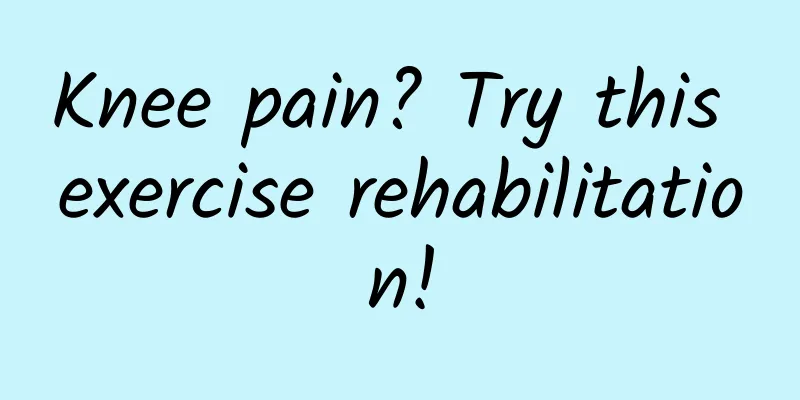Knee pain? Try this exercise rehabilitation!

|
In daily diagnosis and treatment, I often encounter a type of patients who experience knee pain when walking or climbing stairs, and sometimes feel pain when exercising. Although rest can relieve the symptoms, this pain always recurs, which makes people feel very distressed. These patients usually undergo imaging examinations, and the results show partial ligament tears, cartilage wear, and joint aging. Doctors will advise them to walk less and rest more, and if that doesn't work, they will have to undergo joint replacement surgery. However, patients always ask: "Is there any way to avoid surgery? I still need to walk and climb stairs in the future." The answer is yes! In most cases, exercise rehabilitation can not only help patients relieve pain and avoid further injury, but can also improve function and reduce the probability of eventually needing surgery. There have been many high-level clinical studies and guidelines summarizing the effectiveness of exercise rehabilitation (Figure 1), and we have also begun to think more about the characteristics and activity mechanisms of the knee joint itself. Figure 1 The knee joint can be divided into two parts: structural stability and mechanical stability: ——Structural stability: the density and alignment of the bones themselves, the cushioning effect of cartilage, the role of ligaments in limiting excessive movement, etc., are usually determined by genetics; (Figure 2) —— Mechanical stability: refers to the muscles connected to or across the knee joint. There are many of these muscles, many of which even extend from the hip joint (Figure 3); Figure 2 Figure 3 The structural stability of the knee joint allows our knee joint to complete activities within a limited range, avoiding irreversible serious damage beyond the limited range. However, overuse can cause structural damage. If our activities lack mechanical stability control, repeated additional stress will be exerted on the structure. When it exceeds the tolerance range, it will cause pain or gradual damage, thus forming a vicious cycle. (Figure 5) Figure 4 Figure 5 Perhaps simple rest can prevent the tissue from being stressed, but it may also cause the tissue's ability to withstand stress to gradually decrease. Therefore, scientific activities and enhanced mechanical stability of the knee joint are the key to restoring normal function without pain. The body's own ability to adapt and adjust is actually very powerful. With the help of a physical therapist, gradually entering a virtuous cycle is the key to long-term stability. We can call knee pain caused by poor mechanical stability "poorly controlled knee pain". This knee pain will naturally disappear if the control of the knee joint is improved. Rehabilitation usually includes two parts: 1. Adjust the way you exert force in your daily life activities, especially avoid buckling your knees when pushing off the ground, so as to reduce the burden on your knees and thus reduce the occurrence of pain (Figure 6); Figure 6 2. Self-therapeutic practice methods mainly include three aspects: - Stretching and relaxation can help reduce the occurrence of knee pain by relieving muscle tension, increasing joint flexibility, improving range of motion and relaxing the nervous system, including stretching/foam rolling; Quadriceps stretch (Figure 7):
Foam roller relaxation on the outer thigh:
Figure 7 Figure 8 -Strength exercises can improve your ability to balance and strengthen the corresponding muscles, which can reduce the burden on the knee joint, improve the stability of the knee joint, and thus reduce the occurrence of pain; it can also help increase bone density, thereby improving bone strength and tolerance. This is very important for reducing the occurrence of fractures and bone and joint pain, especially for the elderly and people with osteoporosis. Side bridge exercise (Figure 9):
Fig. 9 -Applied exercises help the brain learn to apply in practice, reduce the chances of joint instability and abnormal stress during exercise, improve the way and posture of exercise, thereby reducing the risk of knee joint injury and alleviating pain. Single-leg squat-contralateral leg against the wall (Figure 10):
Fig.10 Except for some muscle soreness and stretching that may occur during the first relaxation exercise, subsequent strength exercises should only cause muscle soreness without any joint discomfort or familiar pain. This shows that the force applied during training is correct. If you keep doing it, the pain will usually continue to disappear, and you will be full of energy in your daily activities. You may even get a pleasant byproduct like a "perky butt." As for those who are worried about whether their legs will become thicker, please don't worry. The intensity of these exercises is far from increasing muscle circumference, so you can practice them with confidence. Of course, the rehabilitation process takes time. Only by maintaining a positive attitude and persisting in practice during the rehabilitation process can you achieve the best rehabilitation results. Note: When doing strength exercises and stretching and relaxation, you should make reasonable choices and arrangements based on your individual situation and professional guidance, avoid overtraining or improper exercise, and ensure the best rehabilitation effect; if you still feel discomfort such as instability/stuckness in the knee joint, or have obvious swelling reactions no matter how you adjust, it is recommended to see a doctor to clarify the problem before choosing the appropriate treatment and exercise plan. Because different people may need different treatment methods, it is recommended that you consult a doctor or professional physical therapist in case of uncertainty to develop a rehabilitation plan suitable for your individual situation. |
>>: The interference of chylosing blood on blood routine is often overlooked by us
Recommend
Can I take Amoxicillin capsules during breastfeeding?
Women need to feed their babies during breastfeed...
Are there any benefits for women to drink a cup of brown sugar water every day?
As we all know, brown sugar is very beneficial to...
Caesarean section is tighter than natural birth
There are two ways for women to give birth: natur...
There is black sticky substance in the girl's lower body
The presence of black and sticky substances in a ...
You have to know these common sense about abortion!
Abortion is also called artificial abortion, or t...
The correct way to use liquid foundation, makeup novices, please read this
Liquid foundation is one of the indispensable ite...
Picture of female heart
The heart is very important to everyone. Generall...
How many days does a woman's menstrual period usually last? Five things to pay attention to during menstruation
Women's menstrual cycle is generally 28-30 da...
How long does it take to get an abortion during pregnancy?
Women hold up half the sky. Today, women occupy a...
How long is the lifespan of dental implants? Dentist: Remember these points and you may be able to use them for life
Tooth loss affects life Long-term tooth loss will...
8 months pregnant heartburn
When a pregnant woman is eight months pregnant, s...
Why does a woman have a fever?
It is very common for the human body to have a fe...
Congenital primordial uterus
The uterus is a very important organ for women an...
Can breast hyperplasia turn into breast cancer?
Breast hyperplasia is relatively common, especial...
Cervical polyp removal
Every woman should be aware of the serious impact...









